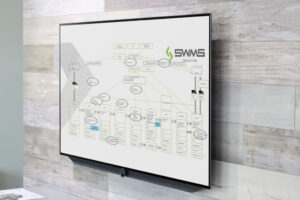The management and controlling of our customer - a medium-sized company active in industrial services - uses Microsoft Excel to plan, control and evaluate the operational activities. The approximately 100 employees are on site at the customer's site, so that billable manpower hours to be worked, the available resources and the current and forecast order backlog must be efficiently managed in a business-like manner.
Project Manager SWMS
Challenge
After work is before work - After the successful deployment on site, further work must be carried out in the industrial service. This includes documentation obligations for the assignment, invoicing for the end customer including proof of activity and accounting for the fitters including all assignment-specific allowances.
The basis of these downstream activities is the so-called assembly report, which historically is filled out as a paper report by the fitters on site. Copied several times for invoicing, evidence in the system documentation and for rewards, it is the decisive basis for the customer, the service company and the staff.
An app for time tracking? Actually a good and obvious idea, but due to specific requirements such as customer-specific form templates, the need to store physical documents on site or the consideration of flexible teams, attempts with standardized software-as-a-service solutions unfortunately did not lead to success.
Proceedure
After the extensive as-is analysis of the process, the gaps between requirements and the previously used SaaS solution were identified and analyzed. As a result, the specific requirements could not be met by the purchase systems available on the market.
A lean solution based on existing services and tools from the cloud sector was therefore designed and the first version implemented within 4-6 weeks. The decisive factor for success was to understand the documentation process precisely and to "think laterally" with regard to the solution instead of copying supposedly existing solution approaches. The interviews with the fitters revealed that PDF forms are preferred to an app for the assembly reports. In order to still have the advantage of digitally recording all data, the solution we have developed now enables a largely fully automated process.
Roughly sketched, this looks like this:
The service teams are divided up in the disposition and assigned to an order. When the status of the order changes, a message is generated that automatically pre-fills the assembly report in the order header and sends it to the service teams by email.
The service teams fill in the other lines of the report, ie hours and activities as well as materials. This report is brought back into the system as a file, initially by e-mail and now via the upload portal. A version can be printed out directly and stored on site in accordance with the regulations.
All data from the form is read automatically, a whole series of checks are carried out automatically and the employee is informed directly in the event of problems.
If everything is OK, a manual check is carried out in a so-called site manager release and the report is finally approved.
The approval creates automatic reports to the ERP, so that hours and material postings are made to the orders.
All incoming data is used monthly to create the pay slip for the fitters, including automatic DATEV import.
The following image shows the work of the dispatchers in the new portal for checking the assembly reports received and for the site manager approval.
Result
With our solution, our customer was able to make very complex and tiresome documentation work more efficient within a very short time. The solution outlined and ultimately implemented adapts to the individual process. Since standardized software was out of the question for the application after extensive analysis, it was possible to almost completely automate a process with little in-house programming effort and intelligent orchestration of existing cloud services with so-called serverless services, which is now also the basis for further optimization efforts.



